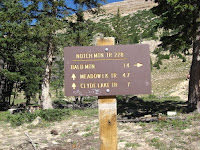For a more extensive hike into the Uinta Mountains, the Naturalist Basin is a favorite place that many hikers enjoy going to. This area features a series of lakes that are at or above 10,500 feet elevation close to the timberline. Along the west boundary of the basin is Mount Agassiz (pronounced "ag-uh-see"), which was named after the Swiss-born American geologist and naturalist, Louis Agassiz. A scramble up the slopes of this mountain offers spectacular views of Naturalist Basin and the surrounding landscape. To enjoy the beauty of the Naturalist Basin more fully, this hike can be turned into a two-day overnighter – the first day in and the second day out. When camping, be sure to observe all wilderness regulations and exercise no trace camping as much as possible. Always check the weather forecast before hiking into the wilderness area and be prepared for sudden storms that include hail, lightning, and strong wind. Keep in mind that subfreezing temperatures can occur at night during any time of the year at this altitude.

To reach the West Highline trailhead coming from the west along I-80, take the exit at Silver Creek Junction (Exit 146) and continue southward along U.S. Highway 189. Take the Park City/Kamas exit (Exit 4) and turn left (eastward) onto SR 248 for approximately 11.5 miles to Main Street in the town of Kamas. Turn left (north) onto Main Street for two blocks, then turn right (east) onto Center Street (SR 150) and continue about 34 miles over Bald Mountain Pass. Look for the turnoff to the right (east) just beyond the Summit County sign. Once on the turnoff, veer to the right (south) to reach the trailhead. From east along I-80, take the Front Street exit (Exit 5) in Evanston, Wyoming and turn left (east) onto SR 150 to head out of town. Utah is entered after about 22.5 miles, yet the route number remains the same. Around 21 miles beyond the border, look for the turnoff to the left (east) just before the Duchesne County sign. After turning onto the turnoff, veer to the right (south) to reach the trailhead. A $6.00 fee is required for a one to three-day recreational use pass that can be paid at the self-service fee box near the trailhead.
 |
West Highline trailhead signs –
Photo credit: Girl on a Hike |
 |
View looking over Blue Lake
from east ridge of Mount Agassiz |
At the trailhead is a wilderness registry, which is always wise to fill out so that officials know your whereabouts and your expected time of return. After all, this is a huge wilderness area that stretches nearly 60 miles from east to west, and it becomes quite easy for inexperienced individuals to get lost. Also, be aware and considerate of backpackers traveling with horses along the trail. The Highline Trail begins by dropping slightly to its junction with the Mirror Lake extension trail at about three-quarters of a mile. Continuing to the left (eastward) towards the Naturalist Basin, the route falls below 10,000 feet elevation before climbing gradually towards Scudder Lake at approximately 2.0 miles. About 2.1 miles beyond Scudder Lake is the Naturalist Basin trail junction to the left (northeast). Here the climb increases a little before leveling off some at the Jordan Lake trail junction just over one mile further. At this point you can choose which direction to take for the lake loop tour around the Naturalist Basin. To continue on to Mount Agassiz, veer to the left (westward) and continue up the trail that goes between the Morat Lakes towards Blue Lake. Mount Agassiz looms to the northwest of Blue Lake as you make your way north of the lake up the steep rocky slope. While there is some exposure along the north side of the east ridge, the climb is more of a scramble up to the 12,428-foot summit of Mount Agassiz. Great care must be taken, however, while climbing over any loose rock. Total distance from the West Highline trailhead to the summit of Mount Agassiz is approximately 6.8 miles one-way with an elevation gain of about 2,490 feet. This factors in an elevation loss of 440 feet. The loop around the Naturalist Basin is approximately 3.7 miles – added to the 5.2 miles to get there.
 |
Scrambling up the east
ridge of Mount Agassiz |
 |
View of the Naturalist Basin near
the summit of Mount Agassiz
Photo credit: Outdoor Project |









